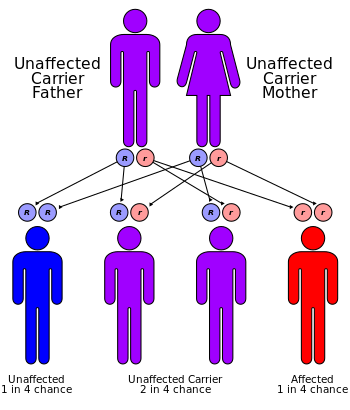Wikipedia:Featured picture candidates/pattern of inheritance of autosomal recessive genes
A chart of inheritance of autosomal recessive genes[edit]
Voting period is over. Please don't add any new votes. Voting period ends on 5 Mar 2013 at 00:20:34 (UTC)

- Reason
- Hard to believe this hasn't already been nominated. This does an amazing job of showing how recessive genes are passed from the parents to the offspring and the difference between an affected offspring and a non-affected carrier of the recessive gene.
- Articles in which this image appears
- The highest EV I think is at Recessive, despite the fact that the article uses smaller preview. Here however, is the full list of the 165 articles that use this image.
- FP category for this image
- Diagrams, drawings, and maps
- Creator
- Cburnett
- Support as nominator --Cat-fivetc ---- 00:20, 24 February 2013 (UTC)
- Support superb encyclopedic value in illustrating how recessive genes work to laymen without having to use a Punnett square. It is also an SVG of excellent technical standard. Purpy Pupple (talk) 00:50, 24 February 2013 (UTC)
- I am in no way attempting to canvas for votes but I'll note that your comment got me to look up the article for Punnett square and nominate the main image from it for FP status here. Cat-fivetc ---- 06:35, 24 February 2013 (UTC)
- Support per above. JKadavoor Jee 06:02, 24 February 2013 (UTC)
- Support - I don't usually get behind graphs and charts, but this one looks pretty well done and is fairly easy to follow. — Crisco 1492 (talk) 07:08, 24 February 2013 (UTC)
- Support -- King of ♥ ♦ ♣ ♠ 07:29, 24 February 2013 (UTC)
- Question. Shouldn't the offspring be half female? I mean 2 of them male and 2 of them female, not all of them hermaphrodites :) Kaldari (talk) 09:54, 24 February 2013 (UTC)
- Good point; but presenting the affected as a girl may not good. :) JKadavoor Jee 13:33, 24 February 2013 (UTC)
- I kind of wish they were all hermaphrodites. By making only one a female sort of makes it feel like this is trying to demonstrate sex-linked inheritance. --jjron (talk) 13:46, 25 February 2013 (UTC)
- Good point but if they mixed and match the offspring genders then it would be confusing as to what exactly it is trying to show and they had to show one female parent and one male parent (a biological fact, not a social commentary) as the sources of the genes. Cat-fivetc ---- 03:58, 26 February 2013 (UTC)
- Support - Coming from a bio nerd... really kind of neat. ceranthor 23:41, 24 February 2013 (UTC)
- Oppose. For illustrating autosomal inheritance, I think sex should be left out of the diagram altogether (at least for the offspring). Including it is problematic either way: showing all offspring as a single sex will confuse readers as to why the sexual phenotypes aren't normally distributed, and showing a mix of sexes without adding another dimension will confuse readers as to whether the inheritance is sex-linked. (How come there isn't there a sexless human symbol anyway?) --Paul_012 (talk) 00:12, 4 March 2013 (UTC)
- Also, I understand that this is supposed to illustrate a condition which follows classic Mendialian inheritance with complete dominance. If this is the case, I'd prefer that the differences between homozygous unaffected individuals and carriers be much more subtle than blue-vs-purple. The diagram should, after all, show that both are phenotypically identical. (The R overrides the r, not mixes with it making purple.) --Paul_012 (talk) 01:04, 4 March 2013 (UTC)
Promoted File:Autorecessive.svg --Armbrust The Homunculus 00:21, 5 March 2013 (UTC)
